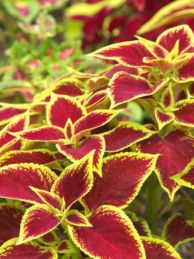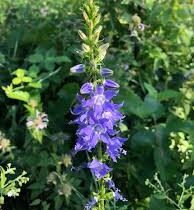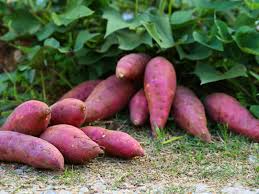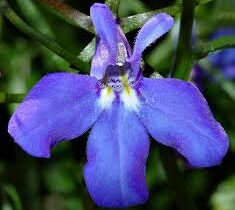Coleus (Solenostemon scutellarioides), often referred to as a flowering annual for shade, is a stunning plant known primarily for its rich and vibrant foliage. While coleus does indeed produce small flowers, it is the plant’s colorful leaves that make it stand out in gardens, especially in shaded or partially shaded areas. Whether you’re planting in containers, garden beds, or as part of a mixed landscape, coleus is an easy-to-grow, low-maintenance plant that provides color and texture from spring to fall. This comprehensive guide will walk you through everything you need to know to grow and care for coleus, from choosing the best varieties to maintaining them through the growing season.
What is Coleus?
Botanical Overview
Coleus belongs to the mint family (Lamiaceae) and is native to tropical regions of Africa, Asia, and Australia. Although it is primarily grown for its foliage, coleus also produces small, tubular flowers that range from white to purple in color. These flowers are often not the focal point for gardeners, as coleus is widely recognized for its attractive, multicolored leaves.
Typically grown as an annual plant for partial shade, coleus is well-suited for shaded gardens or containers. It performs best in moderate temperatures, with an ideal range between 60°F to 75°F (15°C to 24°C). In regions where winters are cold, coleus is generally grown as an annual, though it can be overwintered indoors with proper care.
Why Choose Coleus for Your Garden?
Shade Tolerance
One of the most significant reasons gardeners choose coleus is its excellent tolerance for shade. Unlike many plants that require full sun to thrive, coleus can grow and flourish in environments that receive only partial or filtered sunlight. This makes it ideal for those difficult-to-plant, shaded areas of your garden. If you have spots under trees or on the northern sides of buildings that struggle to receive direct sunlight, coleus can add life to these areas where other plants may fail.
Long-Lasting Foliage Color
Coleus is a perfect choice when you want to add a burst of color to your garden or container garden that lasts from late spring to the first frost. The leaves of coleus come in a wide array of colors, from deep reds and purples to bright greens and yellows. Some varieties even have a mix of several colors on a single leaf, creating intricate patterns that are visually striking.
Low Maintenance
Coleus is one of the more forgiving plants in terms of care. Once established, it requires minimal attention, making it a great option for beginner gardeners. While it thrives in moist, well-draining soil, it doesn’t demand overly complex growing conditions. It also grows quickly, meaning it can fill in empty spaces in garden beds or containers within weeks.
Pollinator-Friendly
Although coleus is grown primarily for its foliage, its small flowers attract a range of pollinators, such as bees and butterflies. This can be especially beneficial if you are trying to cultivate a pollinator-friendly garden. By adding coleus to your garden, you’re not only brightening the space with vibrant colors but also supporting local wildlife.
Choosing the Right Coleus Variety
There are a wide variety of coleus cultivars, each offering different leaf colors, sizes, and growth habits. Some varieties are more compact, while others can grow quite large. Selecting the right variety will depend on your garden size, design, and intended use (containers, borders, hanging baskets, etc.).
1. Kong® Series
- Description: The Kong® series is known for its large, showy leaves that come in a variety of colors, including deep reds, bright yellows, and purple hues. These varieties are perfect for creating a bold statement in garden beds or large containers.
- Height: 18 to 36 inches.
- Best Uses: Great for the back of garden beds, large containers, or as a focal point in your garden.
- Varieties: Kong® Red, Kong® Lime, Kong® Rose, and Kong® Scarlet.
2. ‘Wizard’ Series
- Description: The ‘Wizard’ series offers compact plants with colorful leaves in a range of hues, including pinks, reds, purples, and yellows. These are perfect for smaller spaces or container gardening.
- Height: 12 to 18 inches.
- Best Uses: Ideal for containers, window boxes, hanging baskets, or as border plants.
- Varieties: Wizard® Lime, Wizard® Red, Wizard® Mix.
3. ‘Fairway’ Series
- Description: This series is known for its vibrant color contrasts, with shades of red, pink, and green. The ‘Fairway’ coleus plants are typically more compact and dense, making them great for mixed plantings.
- Height: 12 to 24 inches.
- Best Uses: Ideal for borders, hanging baskets, and mixed containers.
- Varieties: Fairway Red, Fairway Pink, Fairway Green.
4. ‘Colorblaze’ Series
- Description: ‘Colorblaze’ coleus varieties are prized for their bold, fiery colors. From fiery reds to bright greens and yellows, this series creates an eye-catching display wherever planted.
- Height: 24 to 36 inches.
- Best Uses: Perfect for large garden beds, containers, or as a statement plant.
- Varieties: Colorblaze® Chartreuse, Colorblaze® Red, Colorblaze® Lime.
5. ‘Chocolate Mint’
- Description: Known for its rich, dark tones, ‘Chocolate Mint’ coleus is ideal for those seeking a more subdued color palette. It’s a great addition to any garden where you want a striking yet refined look.
- Height: 12 to 18 inches.
- Best Uses: Perfect for containers, shaded garden beds, and as a contrast plant.
- Varieties: This variety is primarily available in the deep green/brown tones that give it the “chocolate” name.
How to Grow Coleus
Ideal Growing Conditions
Coleus is a tropical plant that thrives in warm temperatures and needs a location with at least some partial shade. While it can tolerate direct sunlight, prolonged exposure to full sun can scorch its leaves, particularly in hot climates. For optimal growth, plant coleus in areas that receive morning sunlight or light, dappled shade throughout the day.
- Soil: Coleus prefers well-draining soil that’s rich in organic matter. A slightly acidic to neutral pH (around 6.0 to 7.0) is ideal for healthy growth.
- Watering: Keep the soil consistently moist but not soggy. Coleus plants need regular watering, especially during dry periods. However, overwatering or poorly-drained soil can lead to root rot.
- Temperature: Coleus thrives in moderate temperatures. Keep the temperature between 60°F and 75°F (15°C to 24°C) for the best results. It can tolerate temperatures as low as 50°F (10°C) but may start to suffer if the temperature drops below that.
Planting Coleus in Your Garden
If you’re starting from seedlings or nursery plants, wait until after the last frost to transplant coleus into your garden. Coleus plants should be spaced according to their variety, generally ranging from 6 to 18 inches apart, depending on their mature size.
- Prepare the Soil: Amend the soil with compost or other organic matter to ensure it drains well and is rich in nutrients.
- Transplanting: Plant coleus in a spot that receives partial shade. Space the plants 12-18 inches apart for optimal airflow and to avoid overcrowding.
- Container Planting: Coleus can also be grown in containers. Select a well-draining potting mix and ensure the container has drainage holes to prevent waterlogged roots. In containers, coleus requires more frequent watering, particularly during the hot summer months.
Starting Coleus from Seed
You can start coleus from seed indoors 6-8 weeks before the last expected frost date. Begin by sowing the seeds in a tray or small pots filled with a light, well-draining potting mix. Gently press the seeds into the soil without covering them, as they need light to germinate. Keep the soil moist and warm, ideally between 70°F and 75°F (21°C to 24°C).
Once the seedlings have grown large enough to handle, transplant them into larger pots or directly into the garden after the last frost.
Care and Maintenance of Coleus
Fertilizing
Fertilizing your coleus helps ensure it grows strong and vibrant throughout the season. A balanced, water-soluble fertilizer applied every 4-6 weeks is usually sufficient for optimal growth. However, avoid over-fertilizing, as this can lead to lush foliage with fewer flowers and a leggier growth habit. Coleus generally does not require heavy feeding, so err on the side of caution.
Pruning and Deadheading
Pruning coleus regularly will encourage bushier growth and a fuller appearance. Pinch back the growing tips of the plant to encourage side shoots, creating a compact, dense shape. If your coleus starts to flower, you can deadhead the flowers to encourage more leaf growth.
Tip: In late summer, coleus may begin to leg up and lose its bushiness. Regular trimming will help maintain a neat, full shape.
Pest and Disease Management
While coleus is relatively pest-resistant, it can occasionally attract pests such as aphids, whiteflies, or spider mites. If you notice yellowing leaves or a sticky residue on the plant, inspect it closely for these pests. A gentle spray of water or insecticidal soap will help control most pests.
Coleus is also susceptible to certain diseases, particularly powdery mildew in humid conditions or when airflow is poor. To prevent fungal issues, avoid overcrowding your coleus and ensure it has good air circulation. Infected plants should be removed promptly to prevent the spread of the disease.
Companion Planting with Coleus
One of the great benefits of coleus is its versatility as a companion plant. It pairs well with other shade annuals such as impatiens, begonias, and fuchsias. The contrasting colors of coleus can complement these plants’ flowers, adding texture and vibrancy to your garden. Consider combining coleus with other flowering annual plants for shade for a lush, colorful display.
Overwintering Coleus
Although coleus is typically grown as an annual, it can be overwintered indoors if you live in a climate with cold winters. There are two primary ways to overwinter coleus:
- Bring Plants Indoors: Before the first frost, cut back your coleus plants, and bring them indoors to a sunny window. Pot them up in containers with drainage holes and water regularly.
- Take Cuttings: Take 4-6 inch cuttings from your coleus in late summer. Place the cuttings in a glass of water or in moist soil to root. Once rooted, they can be potted up for winter growth.
Conclusion
Coleus is a fantastic choice for gardeners looking to add vibrant color to shaded or partially shaded areas. Its versatility, ease of care, and stunning foliage make it one of the most beloved plants for shaded gardens. Whether you’re using it as a flowering annual for shade, in containers, or as part of a larger landscape design, coleus will add beauty and texture to your garden. By following the tips and techniques in this guide, you can enjoy a flourishing, colorful coleus garden all season long.








Leave a Reply
View Comments